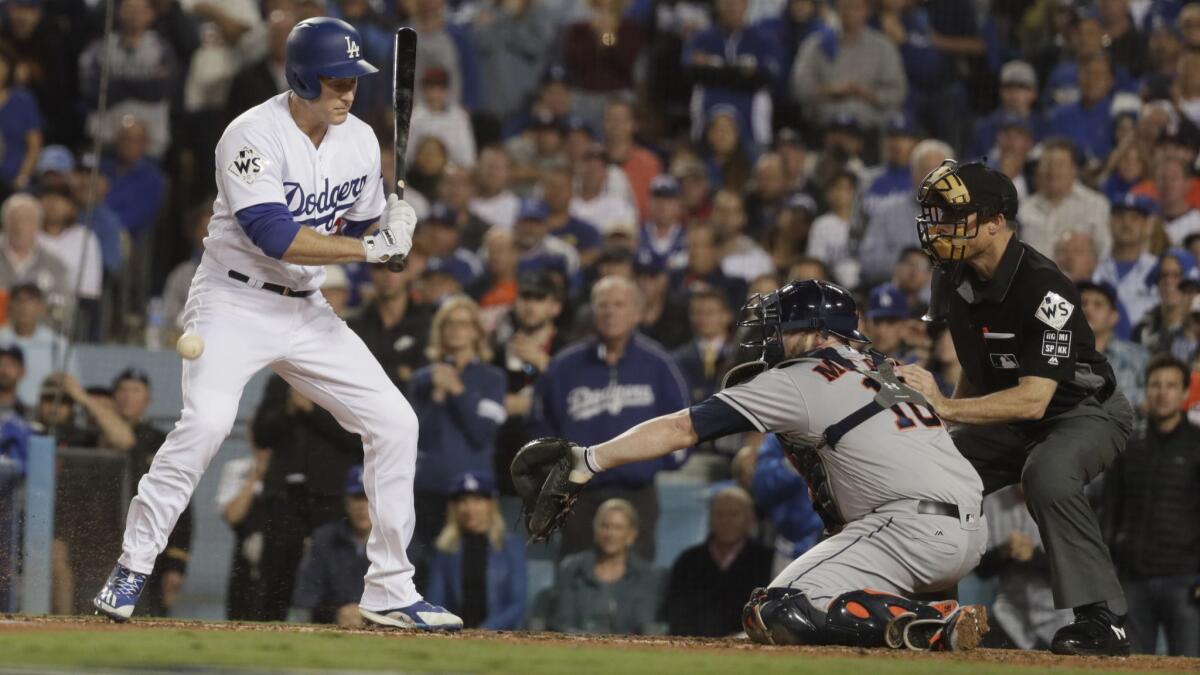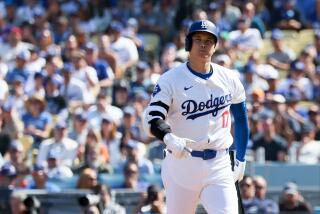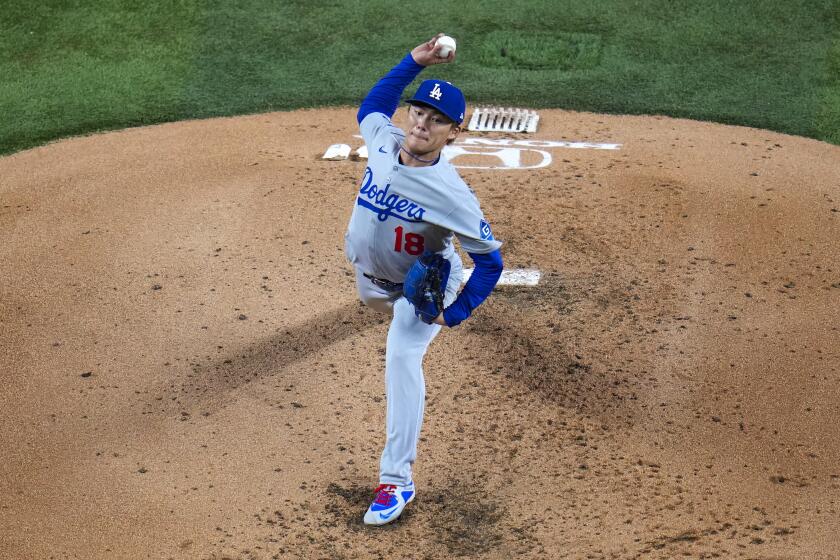Dodgers veteran Chase Utley a shoo-in for the Hall of Pain as he awaits 200th pitch to hit him
- Share via
His old rivals have almost all drifted into retirement, so Tim Hudson perked up when he saw Chase Utley on his television screen a couple of years ago. Utley wore Dodger blue and his hair had gone gray, but his backbone looked the same. When a fastball veered toward Utley’s body, Hudson could guarantee the outcome from his couch in Alabama.
No active player has been hit more than Utley, and no pitcher hit him more often than Hudson, who spent the majority of his 17-year career in Atlanta. On his television, Hudson witnessed a scenario he had experienced seven times himself. The pitcher threw low and inside, in the vicinity of Utley’s feet. Utley absorbed the blow and trotted to first base. Hudson could only smile.
“He’s at the age where osteoporosis might be setting in a little bit,” said Hudson, who at 42 is three years older than Utley. “Those bones might be a little more fragile than they used to be. I wouldn’t quite be so eager to stick my little pigs in front of a 95-mph cutter.”
Utley stowed that fear long ago. Across 16 major-league seasons, he has made six All-Star teams, led the Philadelphia Phillies to a World Series title and blossomed into a veteran sage since joining the Dodgers in the summer of 2015. Now he stands on the verge of a unique achievement: The next pitch that hits him will be No. 200 in his career.
Only seven others in the history of the sport have been hit more often. Utley may never catch fin-de-siecle record holder Hughie Jennings (hit 287 times) or modern leader Craig Biggio (285). But for a player who inspires awestruck devotion from teammates and frenzied hostility from opposing fans, the milestone of 200 feels fitting. Utley performs with a passion for self-sacrifice that borders on masochism. He has rewired his instincts to ignore the natural tendency to avoid objects hurtling toward him.
“Do I like it?” Utley once said. “I mean, I don’t dislike it.”
In a winter marked by austerity, the Dodgers signed only one player to a multiyear contract. That was Utley, who agreed to a two-year, $2-million deal. Utley intends to finish his career as a Dodger. The electricity of his bat has dimmed and his range at second base has shrunk, but the organization still cherishes his presence. During an ugly start to 2018, Utley leads the Dodgers (3-6) in on-base plus slugging percentage. He aims to win an elusive second championship as he polishes a resume for the Hall of Fame.
After Utley retires, a debate will rage about whether he belongs in Cooperstown. During his five-season peak, from 2005 to 2009, Utley trailed only Albert Pujols among position players in FanGraphs’ version of wins above replacement. His 63.3 career WAR compares well with recently inducted second basemen like Biggio (65.8 WAR) and Roberto Alomar (63.6).
Yet his case lacks a boldfaced headline. Utley needs 144 more hits to reach 2,000. He needs 41 more home runs to reach 300. Considered one of the best base-runners of his generation, Utley ranks 14th all-time in base-running runs above average, according to FanGraphs — a convoluted way of showing he was excellent at going from first to third.
So the tidiest encapsulation of Utley’s skill, longevity and mindset might be his propensity for allowing pitchers to assault him with baseballs.
“That’s the best way to explain who he is,” shortstop Corey Seager said. “Total grinder.”
Utley insisted this skill was not innate. He does not recall being hit much in high school in Long Beach or in college at UCLA. As a central cog in Philadelphia’s offensive machine, Utley learned the value of getting on base at any cost. He incorporated it into his pregame routine. To prepare for opportunities, he cataloged the pitchers who pumped inside fastballs and the pitchers who lost breaking balls in the dirt.
“For me, it’s easy to not get out of the way of a ball that’s coming at your shoulder or your back or your leg,” Utley said. “It’s harder when they’re at your feet. That is a natural instinct. It took me a while to be able to fight that tendency to move. Sometimes I still do. But I’ve gotten better at it.”
His age doesn’t hurt, he admitted. “Maybe my reaction time isn’t quite as good anymore.”
Utley led the majors in getting hit by pitches in 2007, 2008 and 2009. He got hit six more times than any other player in 2009. He racked up 10 seasons with 10 or more, and he got clipped nine times as a part-time player in 2017. Utley experienced only one significant injury during this career-long barrage, when Washington Nationals pitcher John Lannan broke a bone in his hand in 2007.
The fracture underscored the peril of this approach. In late March, the Dodgers lost All-Star third baseman Justin Turner for the start of the season when he could not avoid a fastball from Oakland pitcher Kendall Graveman. The ball broke Turner’s wrist. Turner led the Dodgers in hit-by-pitches in 2017, in part by mirroring Utley’s approach, crowding the plate and refusing to cede ground.
There are limitations to Utley’s mettle. “It wouldn’t be beneficial to let the ball hit you in the hand on purpose,” he explained. But the lower half of his body is a different story. At times, Utley appears to subtly place himself at risk.
“He’s not looking forward to it,” hitting coach Turner Ward said. “Although I think sometimes he’s willing to take it.”
During an at-bat against Giants reliever Cory Gearrin last weekend, Utley stutter-stepped toward the plate as Gearrin made his first delivery. After pitches, Utley’s forward momentum sometimes carries him into the opposite batter’s box. He has a knack for maneuvering his legs to anticipate balls as they skim off the dirt.
“I would try to throw him cutters inside, and he would just let it hit him in the back leg or the back foot,” Hudson said. “Just lean into it with his right hip. That’s the kind of player he was. He didn’t mind taking it. The kind of player you hated seeing on the other team.”
Antipathy toward Utley peaked during the 2015 playoffs, when he fractured the leg of Mets shortstop Ruben Tejada on a takeout slide at second base. Utley apologized for the injury. He understood a receipt awaited him on his next trip to New York: Someone on the Mets would try to drill him.
To Utley, it felt mandatory, part of baseball’s unspoken code. On the second night of the series in 2016, Mets pitcher Noah Syndergaard flung a 99-mph fastball behind Utley’s back — it was one of the most anticipated pitches ever aimed at Utley, and it never actually made contact. Utley brushed the dirt of the batter’s box as the umpire ejected Syndergaard. Later that evening, Utley homered twice as jeers rained down upon him.

A more significant example occurred in the sixth inning of Game 6 of last year’s World Series. The Dodgers trailed by a run as Utley pinch hit against Justin Verlander. Utley fell behind in the count. Verlander flung a 1-and-2 fastball. The pitch bounced. Utley tensed his leg and let the ball connect with his right foot. His expression never changed. The team took the lead later that inning.
“He takes ownership of it,” Ward said. “He’s not going to give up ground. That’s his foundation, his place. And if you’re going to intrude it, he’s not going to move away.”
So at some point in the near future, perhaps as early as Tuesday’s game against Oakland, a pitcher will throw a ball in Utley’s vicinity. He will find a way to not avoid it. Utley knew No. 200 was approaching. But he was unsure how to celebrate the milestone.
“I have no idea,” he said. “Do I keep it?”
Utley paused to collect his thoughts. The context of his achievement eluded him.
“Is 200 a lot, compared to everybody else?”
Utley was informed where he ranked historically: Eighth all time.
“All time?” he said. “Like in history?”
Utley burst into laughter.
“Then I’m going to keep it,” he said. “Top 10, in the history of baseball? Hopefully it stays on the field, after it hits me.”
Twitter: @McCulloughTimes
More to Read
Are you a true-blue fan?
Get our Dodgers Dugout newsletter for insights, news and much more.
You may occasionally receive promotional content from the Los Angeles Times.











